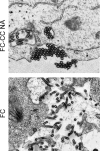Molecular determinants of adaptation of highly pathogenic avian influenza H7N7 viruses to efficient replication in the human host
- PMID: 19939933
- PMCID: PMC2812334
- DOI: 10.1128/JVI.01783-09
Molecular determinants of adaptation of highly pathogenic avian influenza H7N7 viruses to efficient replication in the human host
Abstract
Two viruses isolated during the highly pathogenic avian influenza (HPAI) H7N7 virus outbreak in The Netherlands in 2003, one isolated from a person with conjunctivitis and one from a person who died as the result of infection, were used for an in vitro study of influenza A virus pathogenicity factors. The two HPAI H7N7 viruses differed in 15 amino acid positions in five gene segments. Assays were designed to investigate the role of each of these substitutions in attachment and entry, transcription and genome replication, and virus production and release as determined by hemagglutinin (HA), polymerase proteins, nonstructural protein 1 (NS1), and neuraminidase (NA). These in vitro studies confirmed the roles of the E627K substitution in basic polymerase 2 (PB2) and the A143T substitution in HA in pathogenicity observed in a mouse model previously. However, the in vitro studies identified a contribution of acidic polymerase (PA) and NA to the efficient replication in human cells of the fatal case virus, despite the fact that these are rarely marked as determinants of pathogenicity in in vivo studies. With the exception of PB2 E627K, all substitutions contributing to enhanced replication of the fatal case virus in vitro were present in poultry viruses prior to transmission to the human fatal case, indicating that viruses with enhanced replication efficiency in the mammalian host can be generated in poultry. Thus, detailed in vitro analyses of mutations facilitating replication of avian influenza viruses in mammalian cells are important to assess the zoonotic risk posed by these viruses and, in addition, highlight the value of in vitro studies to complement animal models.
Figures






References
-
- Banks, J., E. S. Speidel, E. Moore, L. Plowright, A. Piccirillo, I. Capua, P. Cordioli, A. Fioretti, and D. J. Alexander. 2001. Changes in the haemagglutinin and the neuraminidase genes prior to the emergence of highly pathogenic H7N1 avian influenza viruses in Italy. Arch. Virol. 146:963-973. - PubMed
-
- Beare, A. S., and R. G. Webster. 1991. Replication of avian influenza viruses in humans. Arch. Virol. 119:37-42. - PubMed
-
- Belser, J. A., O. Blixt, L. M. Chen, C. Pappas, T. R. Maines, N. Van Hoeven, R. Donis, J. Busch, R. McBride, J. C. Paulson, J. M. Katz, and T. M. Tumpey. 2008. Contemporary North American influenza H7 viruses possess human receptor specificity: implications for virus transmissibility. Proc. Natl. Acad. Sci. U. S. A. 105:7558-7563. - PMC - PubMed
Publication types
MeSH terms
Grants and funding
LinkOut - more resources
Full Text Sources
Research Materials

